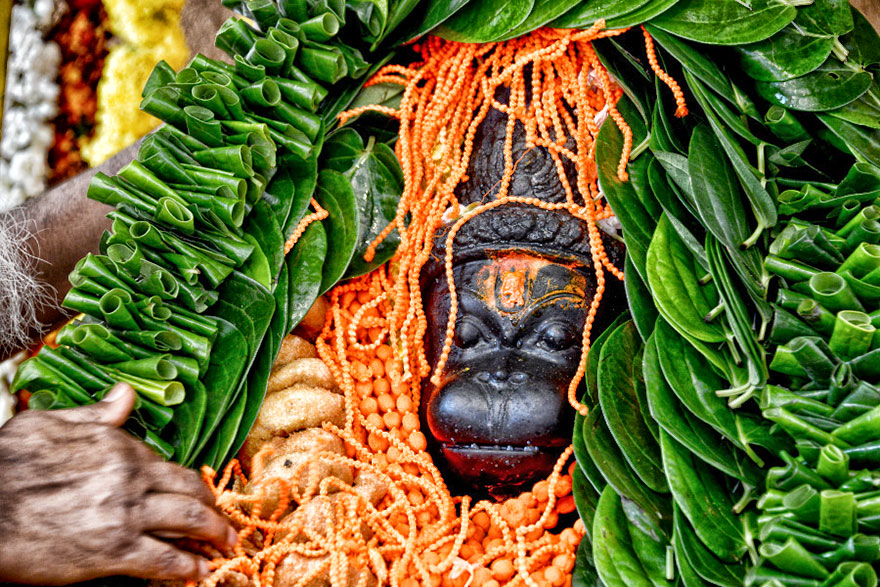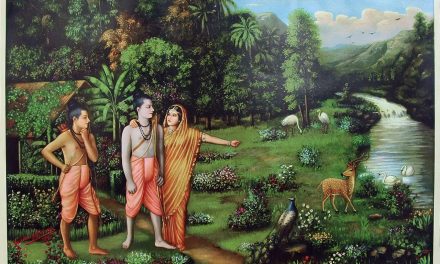The betel leaf has an interesting significance in our lives. I occasionally enjoy the pleasure of a delicious paan beeda with my family at the end of a hearty meal. It is interesting to watch how the paan is made in front of you at the little paan beeda stall present in front of most restaurants in India.
In traditional terms we call this thamboolam, when we offer beeda after meals and to people whom we invite during special occasions. In all functions and ceremonies, the presence of betel leaves is compulsory and worshipping is simply not done without betel leaves. That is our custom.
I was recently listening to someone who was explaining the dos and don’ts of offering a thamboolam and found it interesting.
The dharma for a women in a household is to serve food to the guest, children and her husband before she can satisfy her appetite. Later, the women should consume thamboolam along with her husband every day. The husband is not allowed to accept thamboolam from any woman other than his wife. How can the husband accept thamboolam from a man or woman at a beeda shop? This is permissible as long as the thamboolam is not folded and the husband can accept from anyone.
There is special way to prepare a thamboolam. Firstly, the tender leaves are soaked in water and picked, and the spine is gently peeled. The less spicy, light green leaf categorised as female is preferred over the dark green, spicy male version. A dash of lime paste is applied to the leaf. Tiny quantities of nutmeg, nut gall, wild turmeric, edible camphor and cardamom is added. Nutmeg, nut gall and wild turmeric are called as jathikai, massikai and kaddukai in Tamil, respectively. Over usage of these ingredients can actually make you dizzy, therefore you have to use the right amount.
The nuts are then thinly sliced with the aid of a specially designed nut cracker.
This is topped with a reasonable quantity of betel nut and liberally topped with rose petals soaked in honey. The leaf is nicely folded into a triangle and consumed. This will leave a refreshing taste in the mouth and helps to relax.
You always say ‘thamboolam podu’ (wear the thamboolam) instead of ‘thamboolam sappidu’ (eat the thamboolam) in Tamil. Wearing thamboolam is akin to wearing a make-up.
By wearing the thamboolam the husband and wife ensure that goddess Saraswati and Lakshmi reside in their mouths. It is believed that goddess of knowledge, Saraswati, resides in the middle part of the leaf and goddess of wealth, Lakshmi, resides in the lower tip of the leaf. The mouth turns red in color and the pleasing fragrance of thamboolam remains in the air for some time. Wearing the thamboolam decorates your mouth with colour and aroma for the holy ladies to reside.
We can see that are number of artists and musicians in South India have the habit of consuming thamboolam. We say that the goddess of knowledge saraswati resides in them.
In traditional homes you can find fresh betel leaves, betel nut, nutmeg, nut gall, wild turmeric, edible camphor and cardamom stored in a special compartmentalized container. After a sumptuous meal, especially when guests visit, the different ingredients are folded in a fresh betel leaf to form the triangular shape for a tasty snack. This is normally followed with interesting discussions, listening to traditional music before retiring to bed.
The betel leaves from Kumbakonam in South India are very popular for their unique variety. They are small in size and heart shaped, with a hot and pungent smell.
We understand from scriptures that lord Krishna used to consume thamboolam during his era.
Some scriptures describe Lord Shiva with a beautiful face and red lips stained by thamboolam.
Lots of importance is given to the betel leaf in auspicious functions and ceremony.
Thamboolam has special significance in weddings. The brother of the bride has the privilege to give thamboolam to the bride and this in turn is passed to the bridegroom. The bridegroom in turn gives a thamboolam to the bride. This ritual makes the married couple eligible to consume thamboolam.
Certain sects of people place thamboolam in the mouth of the dead person as his final opportunity for worldly pleasure.
It is said that donating thamboolam can make you a ruler of a nation. This is probably the reason why a number of our prominent personalities chew thamboolam, though I am not certain if they ever donate.
Moreover, it is explained in auyervedic texts how to chew a thaboolam. The first and the second saliva that comes out of chewing has to be spit, the third, fourth and fifth should be taken in. The rest has to be spit to ensure that you don’t suffer from acidity and other effects. You can now understand why, in India, it is simply a custom to spit on roads.
The internet and connected world has now introduced the concept of virtual thamboolam. I have seen number of “thank you for accepting my virtual thamboolam” posts on websites.
There is a proverb in Tamil that literally translates as ‘who offered thamboolam to this bat?’ as tribute to an uninvited guest. Thus, the thamboolam has become a symbol of culture and has significance in our lives.
I keep it simple with my children, and say that thamboolam aids digestion.
Author’s Website: baladrishti.wordpress.com













. R.VENUGOPAL, EX SCIENTIST FROM ATOMIC ENERGY ESTT THANK THE PERSON WHO HAS SENT DETAILS ABOUT BETEL LEAF AND TAMBOOLOAM
WE APPRECIATE Y0OUR EFFORT TO EDUCATE HINDU SOCIETY WELL . THANKING YOU
WITH REGARDS
VENUGOPAL, BANGALORE
MY PARENTS FROM TANJORE
My sincere thanks for having given to the world the value of a pan beeda or thamboolam. It is known that the present day generation do not know the value of such traditional things. This article is an eye-opener to all such people, who do not know the value of thamboolam, including the several married couples.
It is prayed that in the next articles, certain remedies for joint pains may please be given.
Sincerely yours
Informative. Besides this Tambulam develops Satwa Guna . In some Tantrik sadhana, it is mandatory to recite the Mantra after chewing Pan because by this the freshness of mouth increases and it eradicates all bad smell of the mouth.
Many of the herbs mentioned in paan story have health giving properties.
About thaamboolam at shops is called ‘ paan beeda’ or simply ‘beeda’ folded in triangle and sometimes conical, contains normally 2 betel leaves,lime paste, betel nut pieces soaked in water or waferlike pieces and other items like cardamum,tobacco of various types etc are added based on region and person.The spitting is more due to tobacco,mainly from maharashtra onwards to north.South Indians mostly dont use tobacco and so less or no spitting.
Ayurvedic aspect of Thambulam are very impressive. Expect some day more knowledge in such reference if possible.
So thankful to IDO for its great contribution through such articles.
Interesting information concerning the Indian and Hindu culture. This food choice is clearly seen to be a medicine as well here. More information should be circulated in the West concerning the value of the Betel Nut as a digestive aid. It could help many people who consume Andrew’s liver salts routinely, as well as boos India’s exports.
I wish you all the best
Thank you
Jagdish.
16.06.2016
In orthodox circles, there is also a rule about the number of betel leaves to be used at a time! It should not be less than 2, and not 3!
I would like to add a few more significance attached to consuming thamboolam. Usually unmarried adolescents are not permitted
chew it. For a married couple it is an accepted practice. Special significance is that thamboolam contains antibacterial acids. Kissing becomes safer. Moreover it removes bad odour of the mouth.
Periodic use forms a coating on the teeth, and prevents loss of calcium, and protects them. —M.D.Jayabalan
Giving and accepting betel leaves and areca nut while inviting some for marriage function, they signify a promise made that the invitee will certainly attend the function. It is symbolic of a promise and agreement between two parties.
M.D. J
Its Wonderful to Read in Such Detail the Significance of Betel Leaves .
You have Provided an Ocean of Knowledge .
Thanks for your comments and sharing your thoughts.